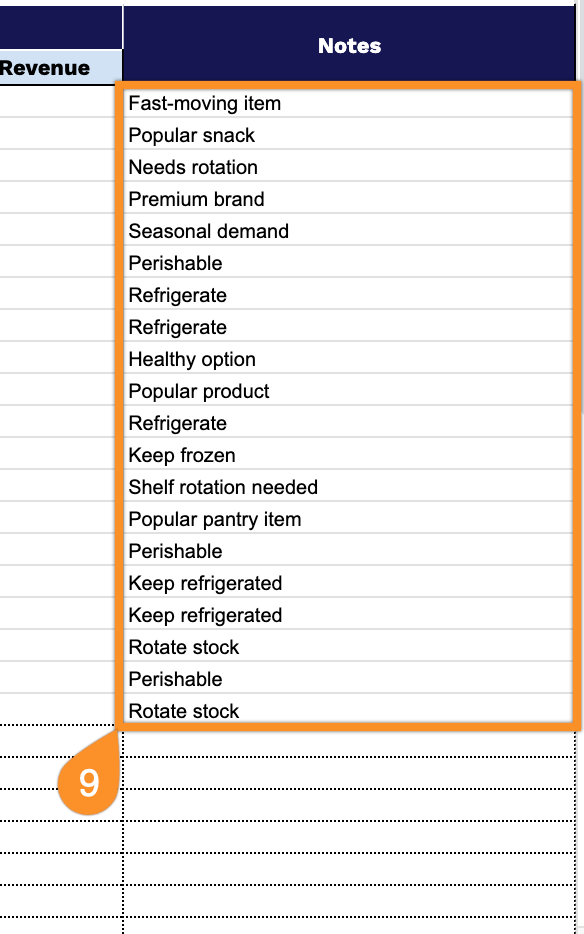Managing inventory is one of those tasks that can quickly become overwhelming for small business owners. You know you need to keep track of what you have in stock, what you’ve sold, and when to reorder, but expensive inventory software often feels out of reach for smaller operations.
Whether you’re running a boutique, managing warehouse stock, or simply keeping tabs on office supplies, staying organized with your inventory directly impacts your bottom line and customer satisfaction.
Our free inventory spreadsheet template provides you with the tools to take control of your stock management using familiar platforms like Google Sheets, Excel, or as a printable PDF.
It’s designed specifically for small businesses that need professional results without the professional price tag.
Quick Jump
ToggleWhat Is a Small Business Inventory Spreadsheet?

A small business inventory spreadsheet is a simple digital file that helps business owners keep track of what products or materials they have in stock.
Many small business owners rely on these spreadsheets because they’re straightforward to set up and use, helping them stay organized without needing to buy specialized software.
Download Spreadsheet Daddy’s Free Small Business Inventory Management Spreadsheet
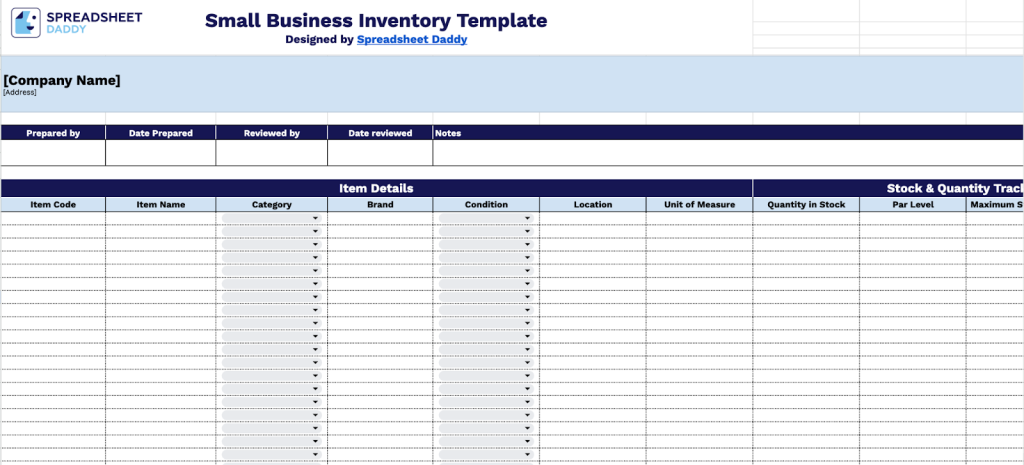
Our inventory template provides small businesses with a straightforward solution for managing their stock, vendor relationships, and financial data within a single spreadsheet.
The template is flexible and can be tailored to your business by adding or deleting columns as needed to fit your particular inventory management requirements.
What’s included
- Comprehensive item cataloging system: Track every product with dedicated columns for item code, name, category, brand, condition, and storage location. Unit of measure specifications ensure accurate quantity tracking across different product types.
- Intelligent inventory monitoring: Monitor current stock levels with quantity on hand and par level columns to maintain appropriate inventory levels. Unit cost tracking provides visibility into purchasing expenses and budget management.
- Supplier relationship management: Keep complete vendor records with supplier contact information, purchase dates, order numbers, and payment terms. This helps you analyze costs and evaluate supplier performance.
- Automated profitability calculations: Built-in formulas automatically calculate profit margins, days left before product expires, total value in stock, and total potential revenue.
How to Use Our Small Business Inventory Spreadsheet Template
1. To begin inventory management, duplicate this template in Google Sheets or download it as an Excel or PDF file.
2. Enter business name and street address details. Include the stock coordinator’s information with the finalization date. Specify the manager’s name, inspection date, and apply Notes for supplementary documentation.

3. Complete the Item Details section by entering all essential product information:
- Item Code: Enter the unique identifier or SKU assigned to each item for inventory tracking and system organization.
- Item Name: Specify the complete product name and detailed description of the item.
- Category: Select the appropriate product classification to organize inventory by type or department (raw materials, finished goods, office supplies, packaging materials, cleaning supplies, etc.).
- Brand: Include the manufacturer or brand name associated with the item for vendor tracking.
- Condition: Document the item’s current state (e.g., new, like new, good, fair) for accurate valuation.
- Location: Record the specific storage area, shelf, or warehouse section where the item is housed.
- Unit of Measure: Specify how the item is counted or sold (each, dozen, pounds, liters, etc.).
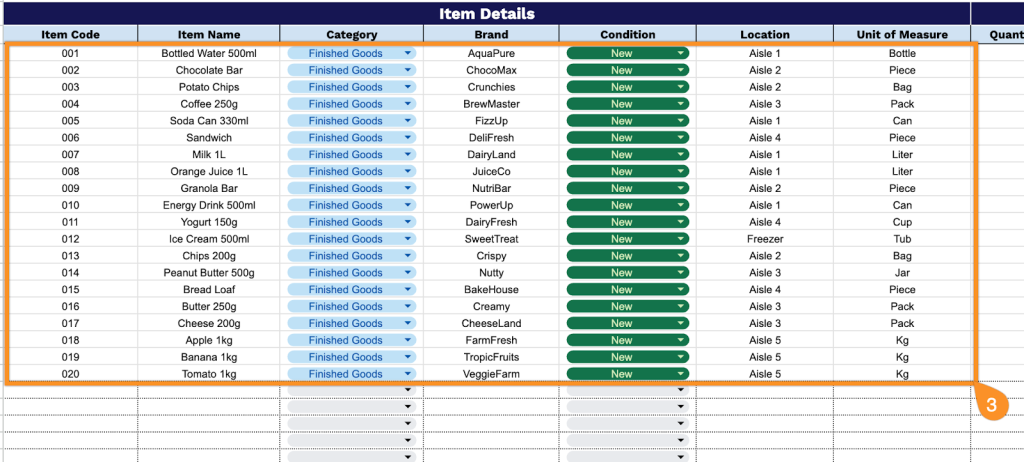
4. Track stock levels and reorder points in the Stock & Quantity Tracking section for optimal inventory management:
- Quantity in Stock: Document the current number of units available for immediate sale or use.
- Par Level: Set the minimum stock quantity that triggers reorder alerts to prevent stockouts.
- Maximum Stock Level: Establish the upper inventory limit to avoid overstock and storage issues.
- Quantity on Order: Record items that have been ordered but not yet received from suppliers.
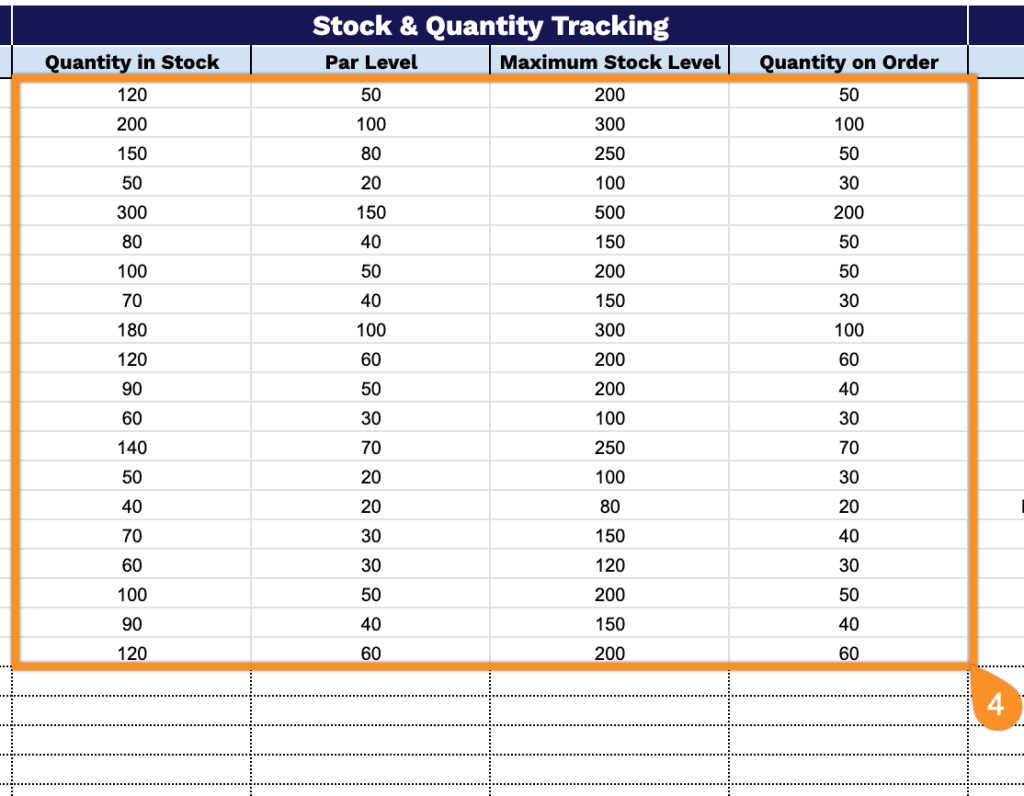
5. Document supplier relationships in the Supplier & Purchase Information section for vendor management:
- Supplier: Enter the name of the vendor or manufacturer providing the items.
- Contact Info: Include phone numbers, email addresses, and key contact persons for ordering and support.
- Purchase Date: Record when the item was initially acquired for age tracking and warranty purposes.
- Purchase Order Number: Document the PO reference for payment reconciliation and record keeping.
- Purchase Price: Enter the wholesale cost paid to acquire each unit for profit margin calculations.
- Payment Terms: Note the agreed-upon payment schedule and conditions with the supplier.
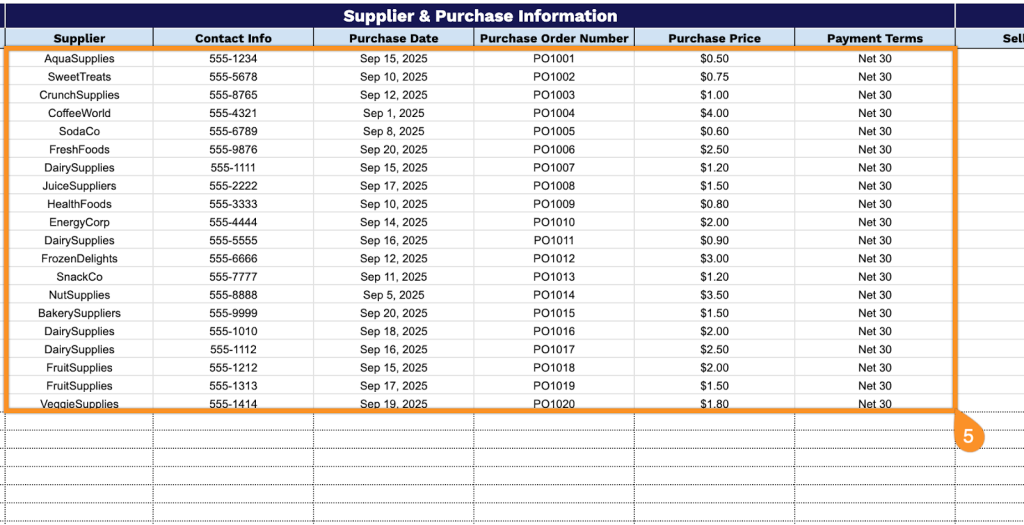
6. Set pricing strategy in the Sales & Pricing section for revenue optimization:
- Selling Price: Establish the retail price charged to customers for revenue tracking purposes.
- Markup Rate: Calculate the percentage increase from cost to selling price for pricing consistency.
- Profit Margin: The template automatically documents the profit percentage earned on each item for financial analysis.

7. Monitor timing and status in the Date & Tracking Information section for proactive inventory management:
- Date Received: Record when the inventory was delivered and entered into stock for age tracking.
- Expiration Date: Note any shelf life or expiration dates for perishable or time-sensitive items.
- Days Left: The template will automatically track remaining time before expiration to prioritize sales and prevent waste.
- Next Reorder Date: Schedule upcoming purchase dates based on consumption patterns and lead times to ensure optimal inventory levels.
- Status: Update the current item condition (active, discontinued, on hold, clearance) for inventory planning purposes.

8. Calculate financial metrics in the Value Calculation section for business analysis:
- Unit Cost: Enter the actual cost per item, including shipping and handling fees for accurate accounting.
- Total Value in Stock: The template computes the total investment value of current inventory automatically for financial reporting.
- Total Potential Revenue: The template will automatically calculate the maximum revenue possible if all stock sells at current retail prices.

9. Capture additional item information in the Notes section when details are relevant.
